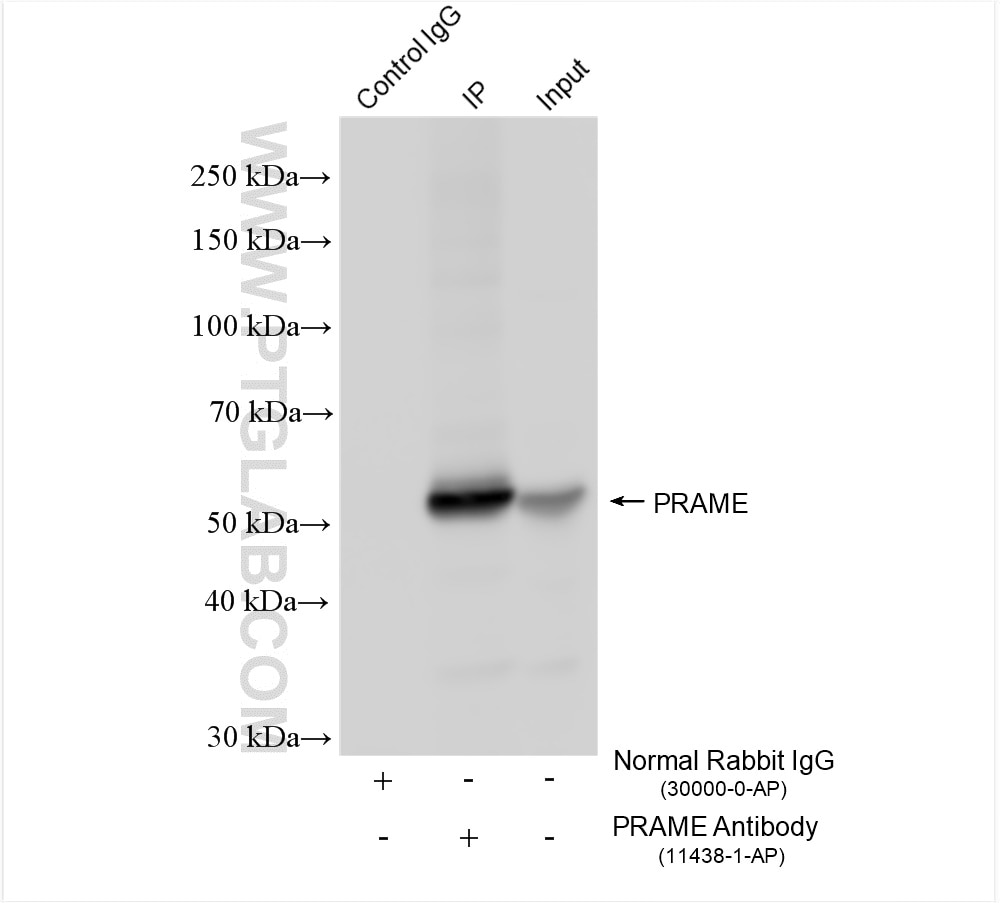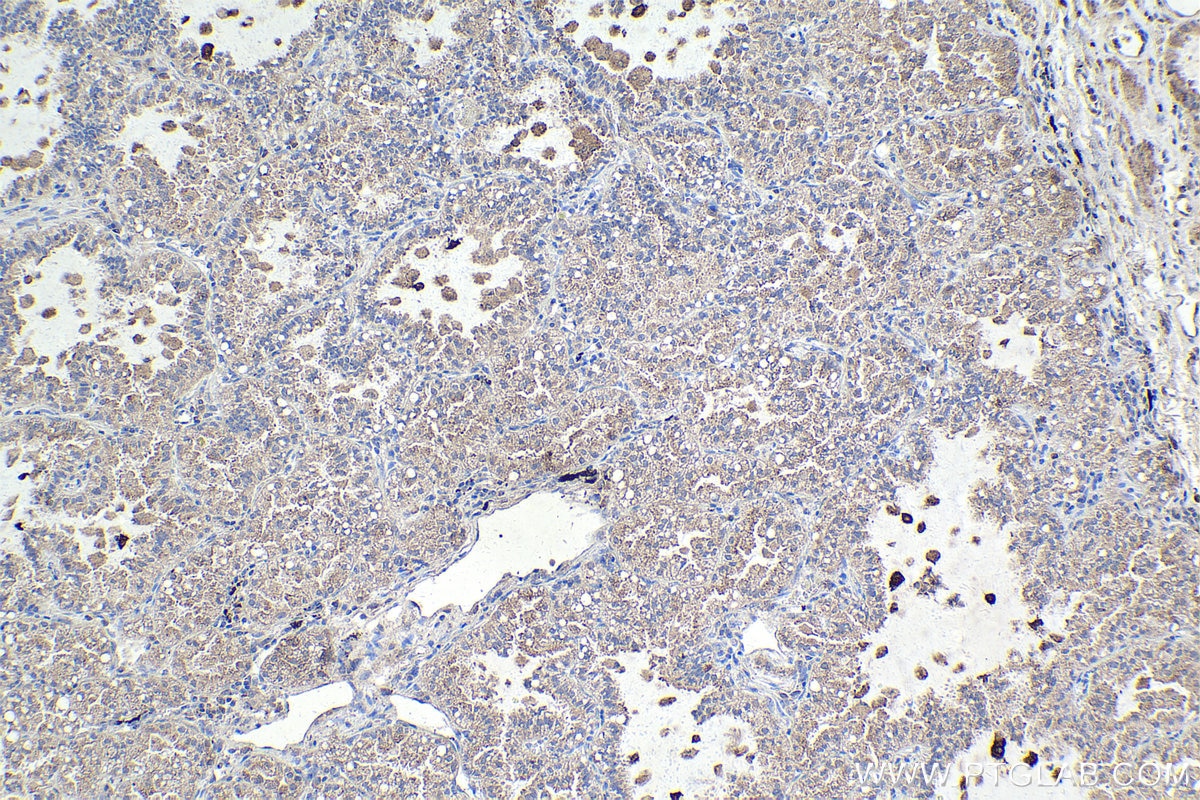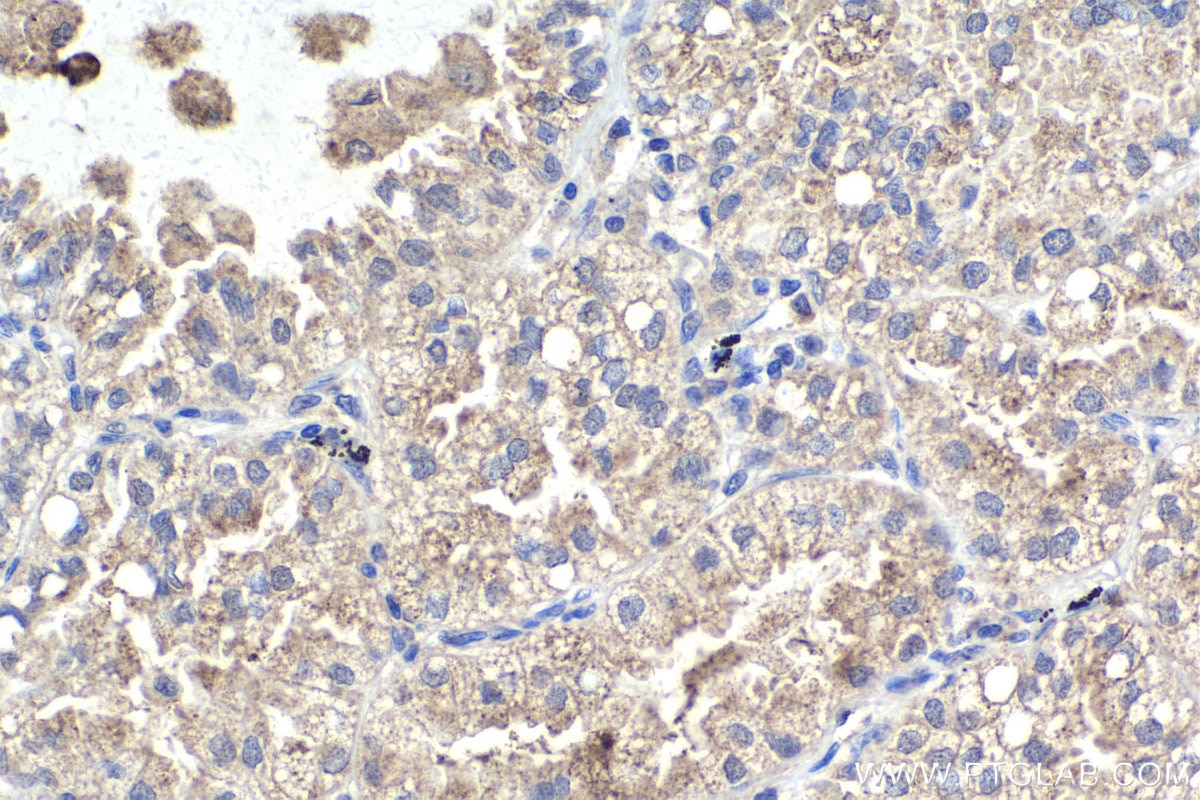Tested Applications
| Positive WB detected in | K-562 cells |
| Positive IP detected in | K-562 cells |
| Positive IHC detected in | human lung cancer tissue Note: suggested antigen retrieval with TE buffer pH 9.0; (*) Alternatively, antigen retrieval may be performed with citrate buffer pH 6.0 |
Recommended dilution
| Application | Dilution |
|---|---|
| Western Blot (WB) | WB : 1:500-1:1000 |
| Immunoprecipitation (IP) | IP : 0.5-4.0 ug for 1.0-3.0 mg of total protein lysate |
| Immunohistochemistry (IHC) | IHC : 1:50-1:500 |
| It is recommended that this reagent should be titrated in each testing system to obtain optimal results. | |
| Sample-dependent, Check data in validation data gallery. | |
Product Information
11438-1-AP targets PRAME in WB, IP, IHC, ELISA applications and shows reactivity with human samples.
| Tested Reactivity | human |
| Host / Isotype | Rabbit / IgG |
| Class | Polyclonal |
| Type | Antibody |
| Immunogen |
CatNo: Ag1906 Product name: Recombinant human PRAME protein Source: e coli.-derived, PGEX-4T Tag: GST Domain: 1-509 aa of BC014074 Sequence: MERRRLWGSIQSRYISMSVWTSPRRLVELAGQSLLKDEALAIAALELLPRELFPPLFMAAFDGRHSQTLKAMVQAWPFTCLPLGVLMKGQHLHLETFKAVLDGLDVLLAQEVRPRRWKLQVLDLRKNSHQDFWTVWSGNRASLYSFPEPEAAQPMTKKRKVDGLSTEAEQPFIPVEVLVDLFLKEGACDELFSYLIEKVKRKKNVLRLCCKKLKIFAMPMQDIKMILKMVQLDSIEDLEVTCTWKLPTLAKFSPYLGQMINLRRLLLSHIHASSYISPEKEEQYIAQFTSQFLSLQCLQALYVDSLFFLRGRLDQLLRHVMNPLETLSITNCRLSEGDVMHLSQSPSVSQLSVLSLSGVMLTDVSPEPLQALLERASATLQDLVFDECGITDDQLLALLPSLSHCSQLTTLSFYGNSISISALQSLLQHLIGLSNLTHVLYPVPLESYEDIHGTLHLERLAYLHARLRELLCELGRPSMVWLSANPCPHCGDRTFYDPEPILCPCFMPN Predict reactive species |
| Full Name | preferentially expressed antigen in melanoma |
| Calculated Molecular Weight | 509 aa, 58 kDa |
| Observed Molecular Weight | 50-58 kDa |
| GenBank Accession Number | BC014074 |
| Gene Symbol | PRAME |
| Gene ID (NCBI) | 23532 |
| RRID | AB_2169351 |
| Conjugate | Unconjugated |
| Form | Liquid |
| Purification Method | Antigen affinity purification |
| UNIPROT ID | P78395 |
| Storage Buffer | PBS with 0.02% sodium azide and 50% glycerol, pH 7.3. |
| Storage Conditions | Store at -20°C. Stable for one year after shipment. Aliquoting is unnecessary for -20oC storage. 20ul sizes contain 0.1% BSA. |
Background Information
The PRAME (preferentially expressed antigen of melanoma) gene was previously shown to be overexpressed in ovarian/primary peritoneal serous carcinoma compared with malignant mesothelioma using gene expression arrays. It is considered a melanocyte differentiation antigen which is overexpressed in both solid and hematologic tumors. In normal tissue, a very low level of PRAME expression is found in normal testis, adrenals, ovary and endometrium. A high level of PRAME expression has been reported for several solid tumors, including ovarian cancer, breast cancer, lung cancer and melanomas, medulloblastoma, sarcomas, head and neck cancers, neuroblastoma, renal cancer, and Wilms'tumor. As a nuclear transcriptional repressor protein, PRAME binds to retinoic acid receptor a, thereby inhibiting retinoic acid induced differentiation, growth arrest, and apoptosis.
Protocols
| Product Specific Protocols | |
|---|---|
| IHC protocol for PRAME antibody 11438-1-AP | Download protocol |
| IP protocol for PRAME antibody 11438-1-AP | Download protocol |
| WB protocol for PRAME antibody 11438-1-AP | Download protocol |
| Standard Protocols | |
|---|---|
| Click here to view our Standard Protocols |










